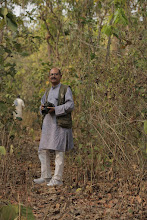A bunch of hooligans belonging to Bharatiya Janata Party and the Congress representing the traders and contractors of Bastar succeeded in creating confusion among the newspaper reading, TV- watching urban middle class about a unique initiative of over 50 concerned citizens who took out a three-day peace march from Raipur to Dantewada in Chhattisgarh from May 6 to 8.
The peace march, whose participants included leading scientist Yash Pal, veteran Gandhian Narayan Desai, social activist Swami Agnivesh and academics Banwarilal Sharma and Ramji Singh, besides scores of social activists and independent journalists, was meant to convey the
message to the nation that 'dialogue and not gun' was needed to defuse the crisis caused by the civil war between the state and the Maoists in the mineral-rich forest areas of the tribal-dominated region of Chhattisgarh, Jharkhand, West Bengal, Orissa, Andhra Pradesh and Maharashtra.
Despite elaborate explanation by Prof Yash Pal, Agnivesh and other eminent citizens about the purpose of their peace march, the Raman Singh government of Chhattisgarh and Union home minister P Chidambaram managed to propagate through the media that the peace march was meant to thwart the 'Green Hunt' and to buy time for the Maoists to regroup themselves.
The media, controlled by the corporate world and the government through their patronage and threat, did their bit by conveying an impression that the peace march met with stiff opposition from the people of chhattisgarh though the vulgar and orchestrated demonstration against the march was only by a handful of hooligans who were seen back-slapping the state police officials.
Unwittingly, the peace marchers too fell into the trap laid by the government and the protesters by confining themselves to addressing a series of press conferences instead of holding one-to-one talk with the people of the towns they passed through. There was also a lack of preparation for the march which should have got placards, banners and pamphlets printed to convey the message of the marchers.
"It was futile to take out the peace march through cities and towns which fall into the 'black-market corridor'. The marchers should have crossed over to the 'red corridor' to establish communication with the adivasis who are caught in the crossfire between the state forces and the Maoists," says Rabi Das, a founder member of the CPI-ML. "The marchers would not have faced any violence, not even a whimper of protest from the Maoists and the adivasis in the 'red corridor' on the other side of the Indravati river," he adds.
Incidentally, Rabi Das and his comrade Nagbhushan Patnaik had renounced violence in the late 1970s after they had come in contact with Gandhian social worker, Malatidevi Choudhury and her husband Nabakrushna Choudhury, the former chief minister of Orissa. Rabi Das has been working in the starvation-prone Kalahandi district of Orissa for over two decades now.
Having met with nasty protest from traders of Jagdalpur and Dantewada, the peace marchers held a review meeting in which several participants stressed the need for crossing the Indravati river into the 'Red Corridor' to express solidarity with the Maoists' cause of giving the ownership rights to the adivasis over land, forest and water bodies, with the rider that taking up guns was not the solution.
Prominent among the peace marchers such as Prof Yash Pal, Thomas Kochery, Dr. Banwarilal Sharma had made it amply clear during their interaction with the press that the faulty development paradigm of the country was responsible for the widening schism between the rich and the poor and that the government was hand-in-glove with the mega corporations and multinational corporations in the plunder of the country's natural resources to the peril of the poor adivasis and the environment.
Given such a stand, the peace marchers could have easily established rapport with the adivasis in the 'Red Corridor' as well as the Maoists fighting for their rights. They could have also tried to convince the Maoists of the efficacy of non-violent direct action by pointing out the success of the people's movements in Baliapal and Gadhamardan in Orissa which were able to stop the proposed national missile testing range and the bauxite mining respectively.
In fact, it is because the people's movement in Orissa has remained peaceful and non-violent that it has been difficult for the government and the mega corporation to push ahead several mega projects in the state. Local villagers in Orissa have been resisting setting up of mega steel plants by the Tatas and the Korean gian Posco for more than five years now as a result of which these companies have not been able to take possession of the land.
The government and the companies, on the other hand, have tried many times to provoke the people by resorting to violence as in Kalinganagar. There have also been attempts by the government to brand these peaceful movements as Naxalite movements so that the state repression can be justified.

No comments:
Post a Comment